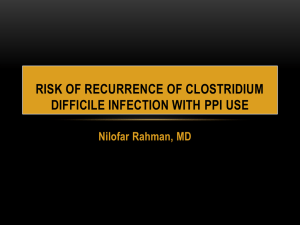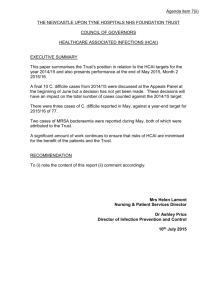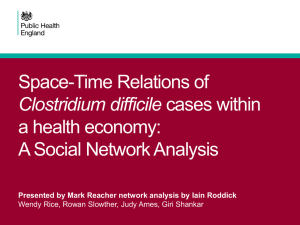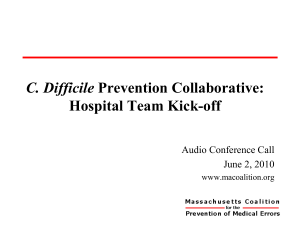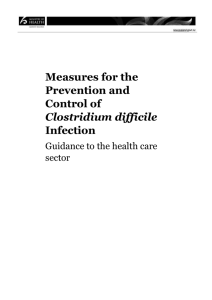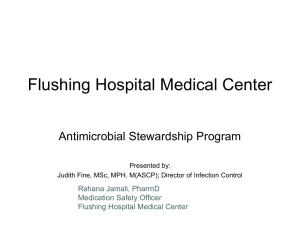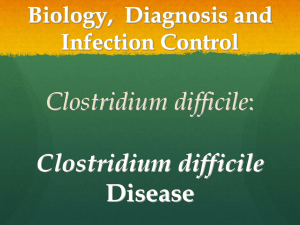Epi_Research_Paper_Example._Good
advertisement
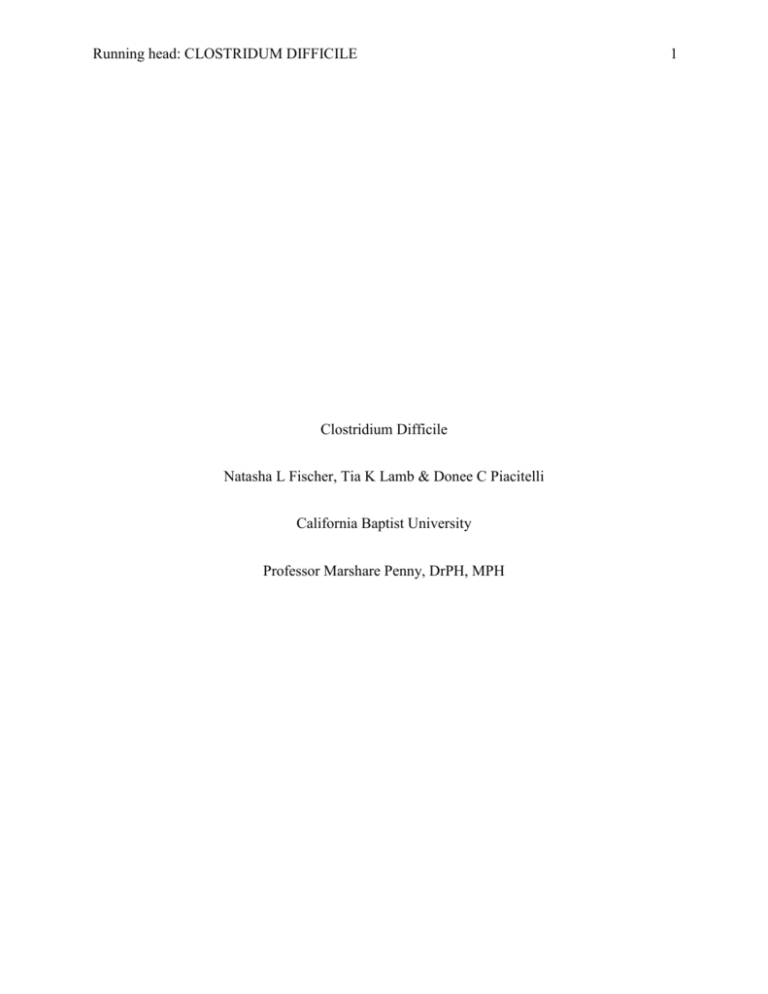
Running head: CLOSTRIDUM DIFFICILE Clostridium Difficile Natasha L Fischer, Tia K Lamb & Donee C Piacitelli California Baptist University Professor Marshare Penny, DrPH, MPH 1 CLOSTRIDUM DIFFICILE 2 In healthy individuals the intestinal tract is home to over a 1,000 harmless microorganism or microflora (Digestive disorders health center, 2015). During times of illness, malnutrition, or medical therapy can cause an environment for microorganism to colonize developing an infectious illness (Porth & Grossman, 2014). Clostridium difficile, also known as C. diff, is an infection that occurs in the intestinal tract by the ingestion of acid-resistant spores causing a spread through the fecal and oral routes. Cases of C. diff infection are more prevalent in hospitalized individuals that older than 65 years of age with recent use of antibiotic therapy (Burke & Lamont, 2014). Clostridium difficile is a gram-positive, spore- forming bacillus that normally resides in 1% to 3% of individual intestinal tract; as well as, found within the environments soil, air, water, human and animal feces and food products (e.g. proceeded meats) (Disease and conditions: c. difficile infection, 2013; Burke & Lamont, 2014). Those that develop an infection from C. diff are caused from antibiotic therapy that disrupts the intestinal flora. The spores of the clostridium are unable to live in an acidic environment, such as the stomach; however, can reside in as a vegetative form in the colon (Porth & Grossman, 2014). When the intestinal flora is weakened the spores from the now overgrowing C diff starts to produce toxins that interfere with protein synthesis, attract inflammatory cells, increase capillary permeability, and stimulate intestinal peristalsis (Porth & Grossman, 2014). The first sign of C diff infection manifests itself with mild to moderate abdominal pain with diarrhea; however these symptoms normally start to occur four to six days after antibiotic therapy (Porth & Grossman, 2014). However in the most recent study done by Burke and Lamont (2014), there is an increase number of community- associated infection in children and individuals without history of antibiotic therapy. CLOSTRIDUM DIFFICILE 3 The pathway of transmission is through the feces and spread to food, surfaces and objects that individuals that are infected with C diff have come in contact with a contaminated surface. C. diff bacteria spores are able to live in an area of a room for weeks or months with improper sanitation (Disease and conditions: c. difficile infection, 2013). With C difficile strains being able to pass through contact of the spore, the geographic distribution of it in North America and Europe is rising as a community- acquired disease with lack of preceding antibiotic therapy in children (Burke & Lamont, 2014). According to the Association for Professionals in Infection Control and Epidemiology (2013), any patient who has had a recent history of antibiotic use and show symptoms of diarrhea or abdominal pain should be suspected of Clostridium Difficile. Also, patients who have recently been in a healthcare setting and have unexplained leukocytosis should be suspected as well (p.15). Though, Clostridium difficile is most commonly contracted in a healthcare setting, it is also shown to be prevalent in low risk patients - those that have not recently used antibiotics or been exposed to a healthcare facility – and therefore, any patient showing signs of diarrhea lasting more than 3 days accompanied by abdominal pain or fever should be tested for Clostridium difficile (Carrico, Weaver & Woodside, p.15). The stool of someone with Clostridium difficile will most likely be accompanied by blood and/or pus. Other signs include loss of appetite, and nausea (Centers for Disease Control and Prevention, 2015, para. 4). Clostridium difficile is acquired by the ingestion of spores, which are usually transmitted from other patients as a result of contamination. These spores are able to resist the acidity of the stomach, and therefore make their way through the stomach and into the small intestines. These spores then “germinate into vegetative bacteria within the small intestines” (Carrico, Weaver & Woodside, p. 10). The normal microbiota of the intestinal tract becoming disrupted provides the CLOSTRIDUM DIFFICILE 4 optimal environment in which Clostridium difficile can flourish, multiply, and produce harmful toxins. Virulence is caused primarily by two large exotoxins A and B. These exotoxins cause inflammation and mucosal damage. This is usually the result of antibiotic treatment, which allows the organisms not affected by the particular antibiotics to proliferate. Therefore, this process allows Clostridium difficile to attach itself to the mucosa of the colon, where it begins the productions of toxins, which results in mucosal disease. The toxin-producing strains of Clostridium difficile causes illness in the patient which can range from mild to moderate diarrhea or pseudomembranous colitis, which is an inflammatory condition of the colon (Carrico, Weaver & Woodside, p.9). When diagnosing Clostridium difficile, watery or loose stools are collected and used for testing. Because it is the toxins produced by the Clostridium difficile spores that causes the disease, tests are ran in order to detect those toxins known as toxins A and B. The most sensitive assay used for the detection of Clostridium difficile is the cytotoxic culture. This is where the organism is cultured and the demonstration of toxin production is observed. The negative aspect, though, is that four days are required for completion, making it impractical for clinical use. Cell cytotoxicity is also used to detect Clostridium difficile which detects toxin B within cell lines. The most widely used method; however, is toxin enzyme immunoassay, or EIA. A simple kit is used to detect toxins A and B. This form of diagnosis is low cost, easy to use, and has a rapid turnaround time (Carrico, Weaver & Woodside, p.16). It is important to look at all aspects of protection when it comes to an infectious disease. This includes primary, secondary, and tertiary prevention. Primary prevention occurs during prepathogenesis, in order to avoid contraction of the disease. Hand hygiene is a good example of primary prevention for Clostridium difficile as well as other healthcare-associated infections CLOSTRIDUM DIFFICILE 5 (HAIs). The APIC (2013) explains that all individuals, especially those who are in healthcare settings frequently should follow strict protocol when it comes to hand hygiene, along with ensuring a clean environment (p.32). Hand washing will not kill Clostridium difficile, for agents used in hand washing are antimicrobial, and are not effective at killing spores. However, soap and water hand washing removes the spores from an individual’s hand. So even though the spores cannot be killed through hand washing, there is physical removal and dilution of those spores. Another form of primary active protection is gloves. Those working in healthcare facilities should always wear gloves when dealing with patients. Wearing gloves and properly removing them followed by correct hand washing, greatly reduces the spread of Clostridium difficile. When it comes to Clostridium difficile primary prevention includes the education of patients, families and healthcare professionals. These individuals should be informed on the infections caused by Clostridium difficile, how it is spread, what they can do to prevent spread, which individuals have a higher risk for infection, and what they can do at home for prevention (Carrico, Weaver & Woodside, p. 32-33). Secondary prevention occurs during pathogenesis and is used on order to detect a disease early and treat it before it becomes symptomatic. Treatment of Clostridium difficile, before it become symptomatic, is not possible. A patient is unaware of the disease until he or she starts to display the symptoms. Once this occurs, the patient is tested for the presents of the toxins. Though, there is no way to detect the disease before it has become symptomatic, early detection is still possible and would aid in helping the patient have a quicker recovery as well as reducing the chance of spreading the infection. The first thing that should happen once a diagnosis is made is for the patient to stop taking the antibiotic that triggered the infection, and antibiotics to treat CLOSTRIDUM DIFFICILE 6 C. difficile, such as metronidazole, vancomycin, or fidaxomicin, should be given in order to stop the growth of the organism. (CDC, 2015, para. 7) Tertiary prevention takes place during late pathogenesis. Once a patient has been diagnosed, contact precautions should be enforced. “Placing patients on Contact Precautions as recommended in the HICPAC/CDC Guideline for Isolation Precautions is a critical step in preventing spread” (Carrico, Weaver & Woodside, p. 37). The infected individual should also be moved to a private room with its own bathroom. If a private room is not available, then the patient should be placed with other individuals diagnosed with Clostridium difficile. Proper personal protective equipment, such as gloves and masks should be used as well (Carrico, Weaver & Woodside, p. 38). Lastly, the patient’s room should be thoroughly cleaned whenever moved and once the patient is discharged. The morbidity and mortality rates of Clostridium Difficile are steadily increasing. Clostridium difficile was responsible for almost half a million infections and was associated with approximately 29,000 deaths in 2011 (Magill, 2014). According to the Multistate pointprevalence Survey of Health Care-Associated infections, it stated that in a recent national prevalence survey, CDI was the most commonly reported pathogen, causing 12% of HAIs, and an estimated 80,400 hospital-onset infections (Magill, 2014). According to the Center for disease control an estimated number of cases over the United States were 453,000 cases. The CDC national and state HAI progress report states that in 2011 about 107,700 hospital-onset Clostridium difficile infections were reported all over the United States (Magill, 2014). The mortality rate for Clostridium Difficile is 6.9 percent after 30 days of being diagnosed and at 1 year after being diagnosed the mortality rate is at 16.7 percent (Magill, 2014). CLOSTRIDUM DIFFICILE 7 There does seem to be some differences in the distribution of the disease between different ages, race, education, and also sex. According to Virginia’s department of health the rate of infection for Clostridium Difficile seem to be two times as high for people who are 85 years old and over rather than for people 65-84 years of age (Schutze & Willoughby, 2013). In regards to sex, it was stated that females have a 30 percent higher hospitalization rate than males do. According to the Center for Disease control and infections the incidence of C. Diff was estimated to be higher in the white population (Magill, 2014). Education definitely has a part to play in the distribution of the disease. Because this infection is mostly a hospital acquired disease it is important for the staff, and also the patients to be educated about the disease and how it is transmitted. If you are working in a hospital it is detrimental that you handle patients with this infection a certain type of way, and if the staff and patients are not educated in such a way, it is evident that they can play a part in spreading the disease even further. There are many other factors that can contribute to the distribution of Clostridium Difficile. In an article written by Magil, Edwards, and Bamberg (2014) it stated that patients exposed to prolonged use of antibiotics may be at higher risk for developing C. Diff, along with other underlying health conditions. There are many control measures that hospitals, patients, and staff must put into play to control Clostridium Difficile. The CDC explains that there may have been an increase in this disease after a change in antibiotics, and changes in the way they practice infection control, in 2004 after they found a new strain of the infection that seems to have an increased virulence and increased antimicrobial resistance (2011). It is important that all hospitals should always monitor the entire new C. Diff incidence, and the rate of all hospital-onset CDI, and it be put in their infection control program (Schutze & Willoughby, 2013). In order to control this epidemic CLOSTRIDUM DIFFICILE 8 one definitely must be educated in how it is transmitted. Since it is known that the transmission of this bacterium is by way of fecal-oral route, and by person to person contact with someone who is contaminated. The Center for disease control states that in order to control Clostridium Difficile in the environment is detrimental to control the spread of C. Diff in health care facilities (Schutze & Willoughby, 2013). People who have symptoms of C. Difficile associated diarrhea should be placed in standard plus contact precaution for the remainder of the diarrhea episode. The center for disease control says that the use of glove is the best proven control measure in preventing the spread of clostridium difficile. It is also said that instead of just using hand sanitizer, washing your hands with soap and water is much more effective in removing the bacteria. Ultimately, Clostridium difficile is an infectious disease that is antibiotic induced diarrhea with abdominal pain. This infectious disease is commonly a hospital acquired disease that is caused by antibiotic therapy. Clostridium difficile can be spread through improper preventive measure; however, proper care includes proper hand hygiene; discontinuation of antibiotic therapy; contact percussion signs; and proper environmental or room cleaning once patient is discharged. With the increase of spread in the United States hospitals are encourage to give education on Clostridium difficile to patients and their families to prevent future infection. In order to decrease the mortality and morbidity rates it is beneficial for hospitals and communities to learn and educate their citizens on how to prevent future spread of Clostridium difficile among the young and elderly. CLOSTRIDUM DIFFICILE 9 References Burke, K. E., & Lamont, J. T. (2014, Jan 13). Clostridium difficile infection: a worldwide disease. Retrieved from US National Library of Medicine National Institues of Health: http://www.ncbi.nlm.nih.gov/pmc/articles/PMC3916678/ Centers for Disease Control and Prevention (2015, February 24). Clostridium difficile infection information for patients. Retrieved April 8, 2015, from http://www.cdc.gov/hai/organisms/cdiff/Cdiff-patient.html Digestive disorders health center. (2015, April 9). Retrieved from WebMD: http://www.webmd.com/digestive-disorders/clostridium-difficile-colitis Disease and conditions: c. difficile infection. (2013, July 16). Retrieved from Mayo Clinic: http://www.mayoclinic.org/diseases-conditions/c-difficile/basics/causes/con-20029664 Information about the current strain of clostrdium difficile. (2011, January 2011). Retrieved from Centers for Disease Control and Prevention: http://www.cdc.gov/HAI/organisms/cdiff/Cdiff-current-strain.html Magill, S. S. (2014, April 3). Clostridium difficile (c. difficile) infections. Retrieved from Virginia. gov: http://www.vdh.virginia.gov/epidemiology/surveillance/hai/cdiff.htm Porth, C. M., & Grossman, S. C. (2014). Porth's Pathophysiology: Concepts of Altered Health States (9th ed.). Philadelphia, PA: Lippincott Williams and Wilkins. Schutze, G., & Willoughby, R. (2013, July 22). Clostridium difficile infection in infants and children. Retrieved 10 April, 2015, from Pediatrics: http://pediatrics.aappublications.org/content/131/1/196.full CLOSTRIDUM DIFFICILE 10 Woodside, J., Weaver, T., & Carrico, R. (2013). Guide to preventing clostridium difficile infections. Guide to Infection Prevention in Emergency Medical Services. Washington, D.C.: Association for Professionals in Infection Control and Epidemiology.

